child lock INFINITI EX 2011 Owners Manual
[x] Cancel search | Manufacturer: INFINITI, Model Year: 2011, Model line: EX, Model: INFINITI EX 2011Pages: 480, PDF Size: 4.04 MB
Page 11 of 480
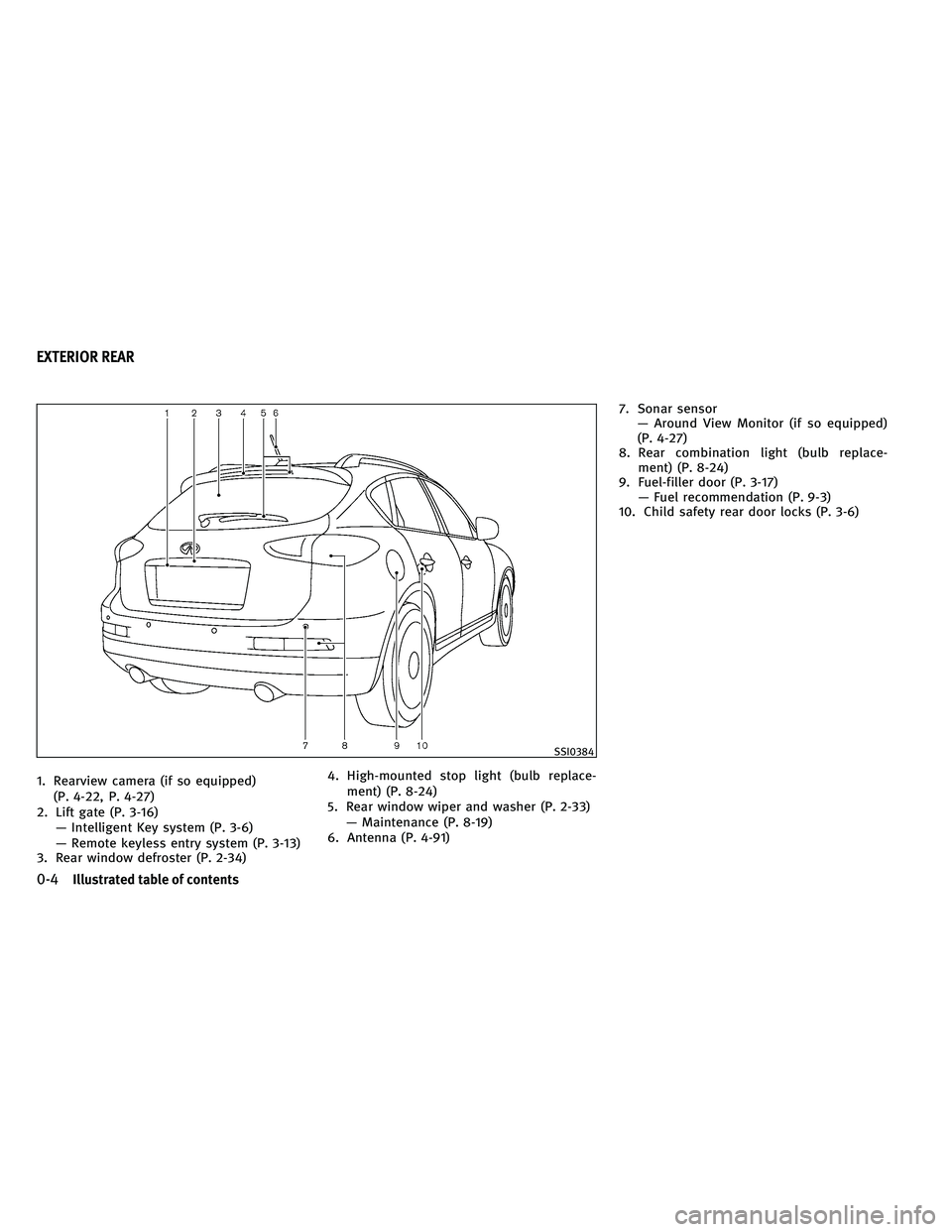
1. Rearview camera (if so equipped)(P. 4-22, P. 4-27)
2. Lift gate (P. 3-16) — Intelligent Key system (P. 3-6)
— Remote keyless entry system (P. 3-13)
3. Rear window defroster (P. 2-34) 4. High-mounted stop light (bulb replace-
ment) (P. 8-24)
5. Rear window wiper and washer (P. 2-33) — Maintenance (P. 8-19)
6. Antenna (P. 4-91) 7. Sonar sensor
— Around View Monitor (if so equipped)
(P. 4-27)
8. Rear combination light (bulb replace- ment) (P. 8-24)
9. Fuel-filler door (P. 3-17) — Fuel recommendation (P. 9-3)
10. Child safety rear door locks (P. 3-6)
SSI0384
EXTERIOR REAR
0-4Illustrated table of contents
Page 21 of 480
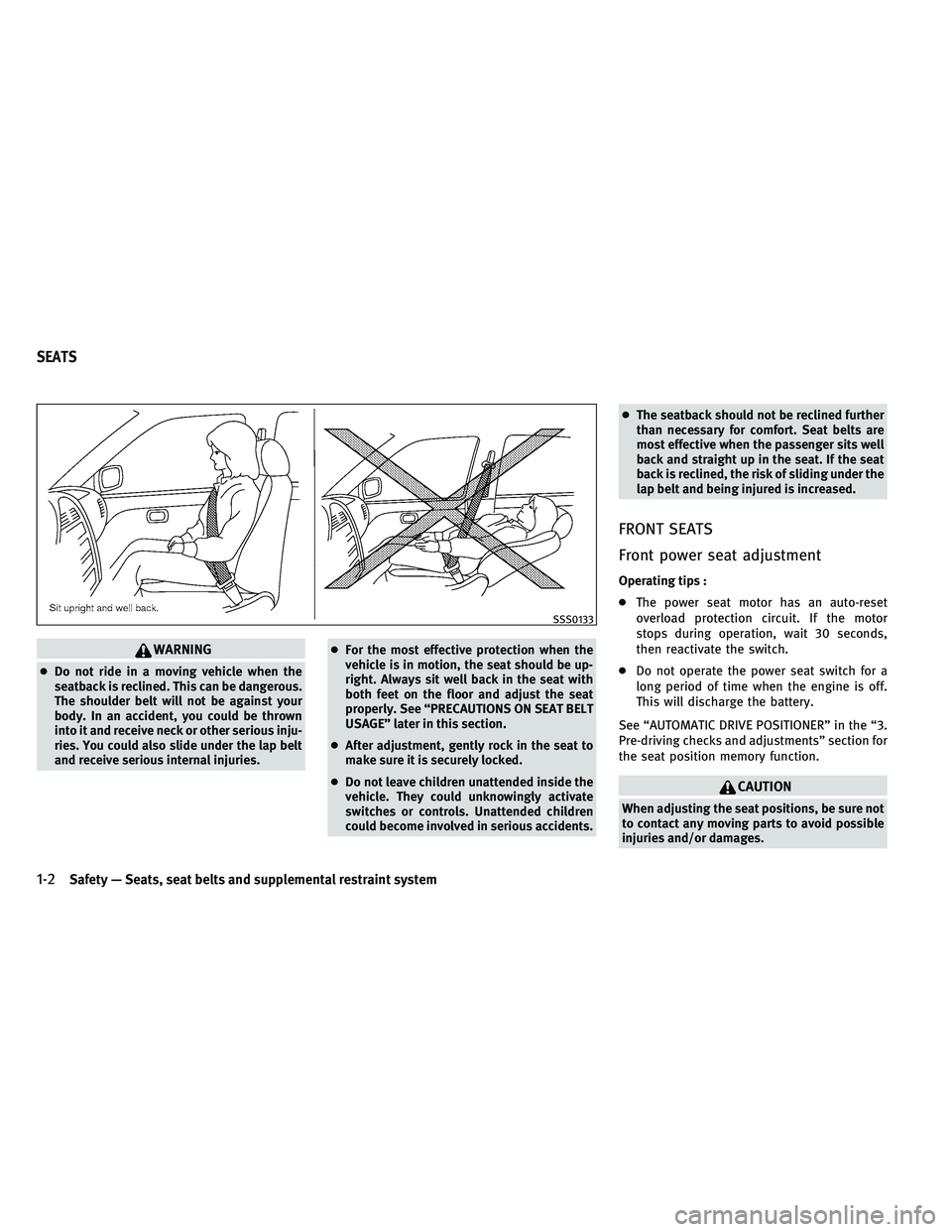
WARNING
●Do not ride in a moving vehicle when the
seatback is reclined. This can be dangerous.
The shoulder belt will not be against your
body. In an accident, you could be thrown
into it and receive neck or other serious inju-
ries. You could also slide under the lap belt
and receive serious internal injuries. ●
For the most effective protection when the
vehicle is in motion, the seat should be up-
right. Always sit well back in the seat with
both feet on the floor and adjust the seat
properly. See “PRECAUTIONS ON SEAT BELT
USAGE” later in this section.
● After adjustment, gently rock in the seat to
make sure it is securely locked.
● Do not leave children unattended inside the
vehicle. They could unknowingly activate
switches or controls. Unattended children
could become involved in serious accidents. ●
The seatback should not be reclined further
than necessary for comfort. Seat belts are
most effective when the passenger sits well
back and straight up in the seat. If the seat
back is reclined, the risk of sliding under the
lap belt and being injured is increased.
FRONT SEATS
Front power seat adjustment
Operating tips :
● The power seat motor has an auto-reset
overload protection circuit. If the motor
stops during operation, wait 30 seconds,
then reactivate the switch.
● Do not operate the power seat switch for a
long period of time when the engine is off.
This will discharge the battery.
See “AUTOMATIC DRIVE POSITIONER” in the “3.
Pre-driving checks and adjustments” section for
the seat position memory function.
CAUTION
When adjusting the seat positions, be sure not
to contact any moving parts to avoid possible
injuries and/or damages.
SSS0133
SEATS
1-2Safety — Seats, seat belts and supplemental restraint system
Page 35 of 480
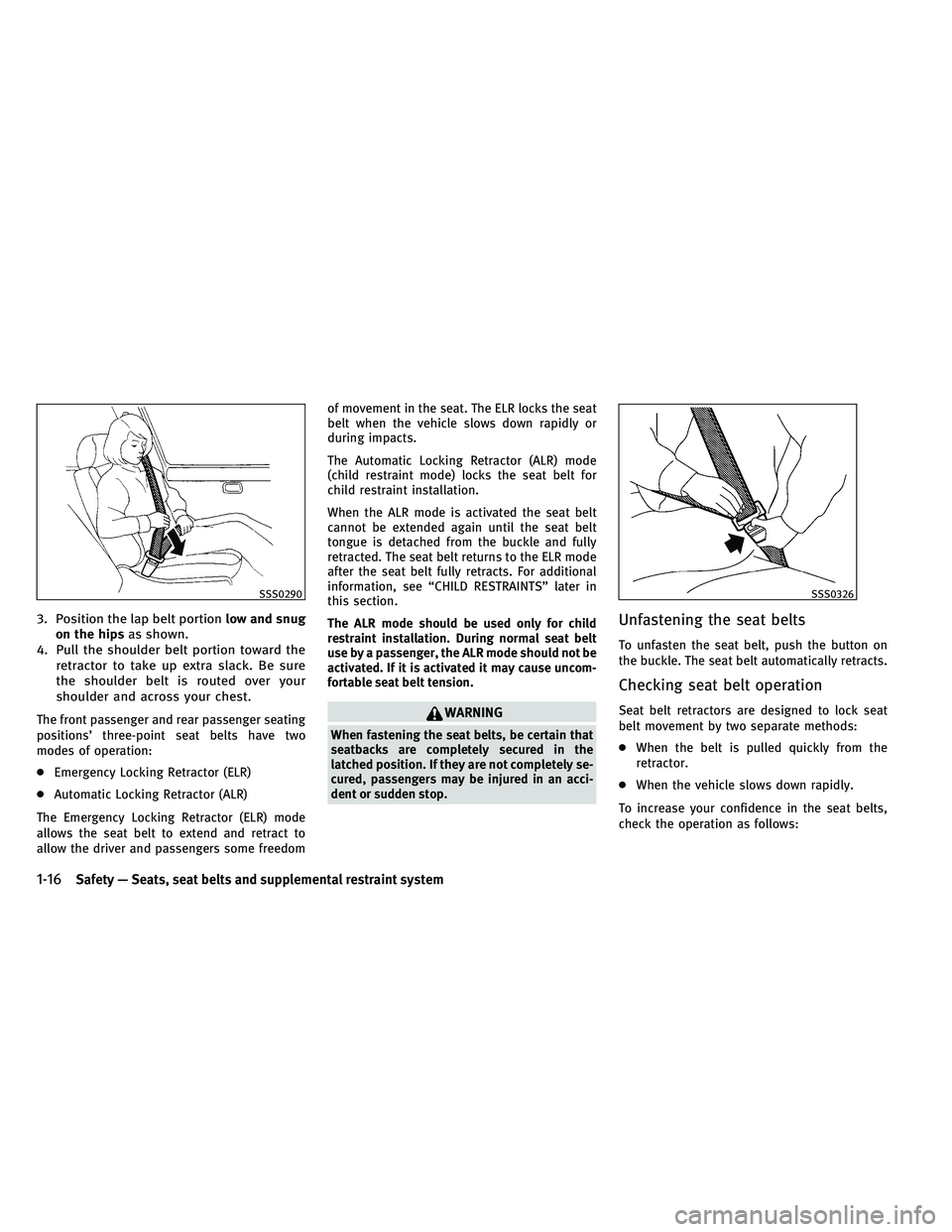
3. Position the lap belt portionlow and snug
on the hips as shown.
4. Pull the shoulder belt portion toward the retractor to take up extra slack. Be sure
the shoulder belt is routed over your
shoulder and across your chest.
The front passenger and rear passenger seating
positions’ three-point seat belts have two
modes of operation:
●Emergency Locking Retractor (ELR)
● Automatic Locking Retractor (ALR)
The Emergency Locking Retractor (ELR) mode
allows the seat belt to extend and retract to
allow the driver and passengers some freedom of movement in the seat. The ELR locks the seat
belt when the vehicle slows down rapidly or
during impacts.
The Automatic Locking Retractor (ALR) mode
(child restraint mode) locks the seat belt for
child restraint installation.
When the ALR mode is activated the seat belt
cannot be extended again until the seat belt
tongue is detached from the buckle and fully
retracted. The seat belt returns to the ELR mode
after the seat belt fully retracts. For additional
information, see “CHILD RESTRAINTS” later in
this section.
The ALR mode should be used only for child
restraint installation. During normal seat belt
use by a passenger, the ALR mode should not be
activated. If it is activated it may cause uncom-
fortable seat belt tension.WARNING
When fastening the seat belts, be certain that
seatbacks are completely secured in the
latched position. If they are not completely se-
cured, passengers may be injured in an acci-
dent or sudden stop.
Unfastening the seat belts
To unfasten the seat belt, push the button on
the buckle. The seat belt automatically retracts.
Checking seat belt operation
Seat belt retractors are designed to lock seat
belt movement by two separate methods:
●
When the belt is pulled quickly from the
retractor.
● When the vehicle slows down rapidly.
To increase your confidence in the seat belts,
check the operation as follows:
SSS0290SSS0326
1-16Safety — Seats, seat belts and supplemental restraint system
Page 45 of 480
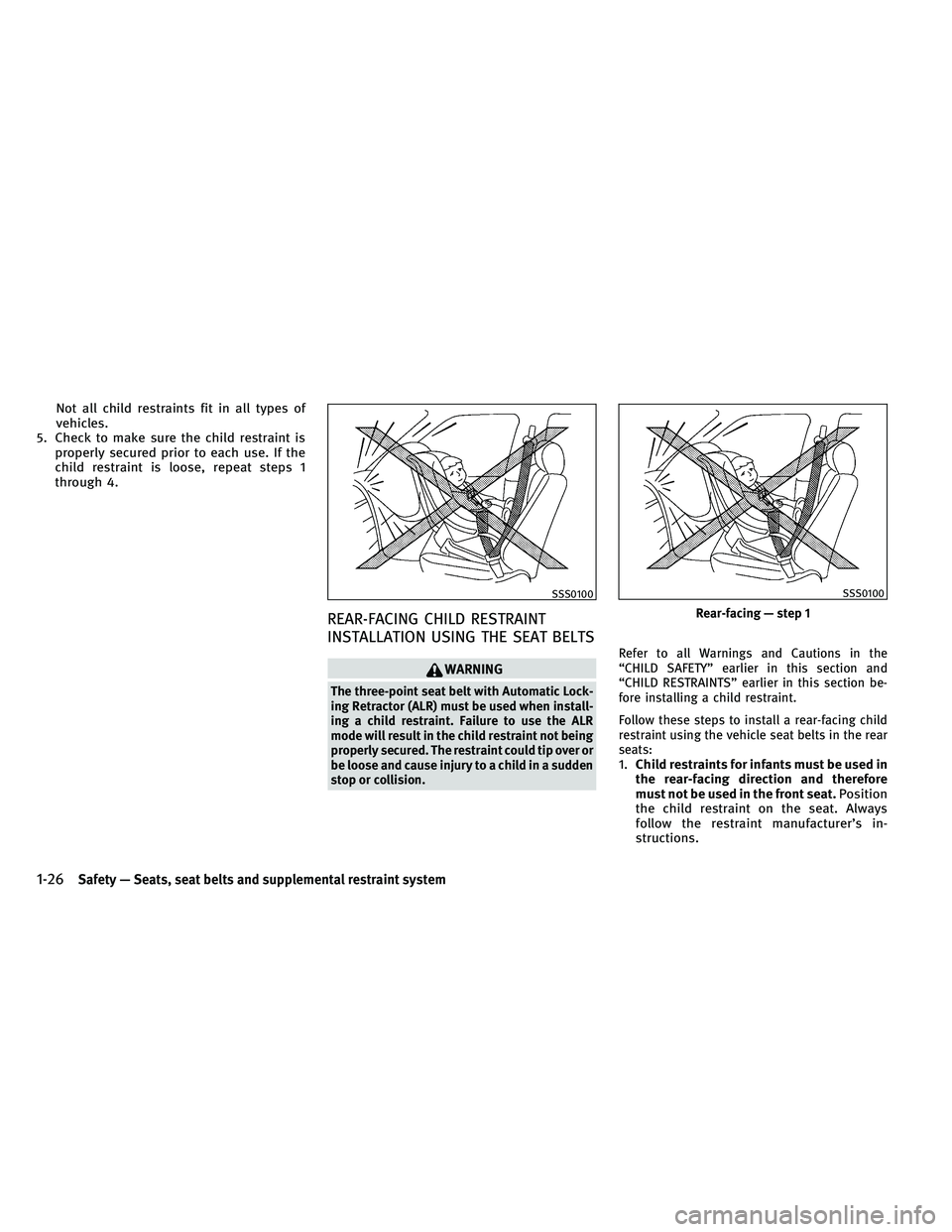
Not all child restraints fit in all types of
vehicles.
5. Check to make sure the child restraint is properly secured prior to each use. If the
child restraint is loose, repeat steps 1
through 4.
REAR-FACING CHILD RESTRAINT
INSTALLATION USING THE SEAT BELTS
WARNING
The three-point seat belt with Automatic Lock-
ing Retractor (ALR) must be used when install-
ing a child restraint. Failure to use the ALR
mode will result in the child restraint not being
properly secured. The restraint could tip over or
be loose and cause injury to a child in a sudden
stop or collision. Refer to all Warnings and Cautions in the
“CHILD SAFETY” earlier in this section and
“CHILD RESTRAINTS” earlier in this section be-
fore installing a child restraint.
Follow these steps to install a rear-facing child
restraint using the vehicle seat belts in the rear
seats:
1.
Child restraints for infants must be used in
the rear-facing direction and therefore
must not be used in the front seat. Position
the child restraint on the seat. Always
follow the restraint manufacturer’s in-
structions.
SSS0100
Rear-facing — step 1
SSS0100
1-26Safety — Seats, seat belts and supplemental restraint system
Page 46 of 480
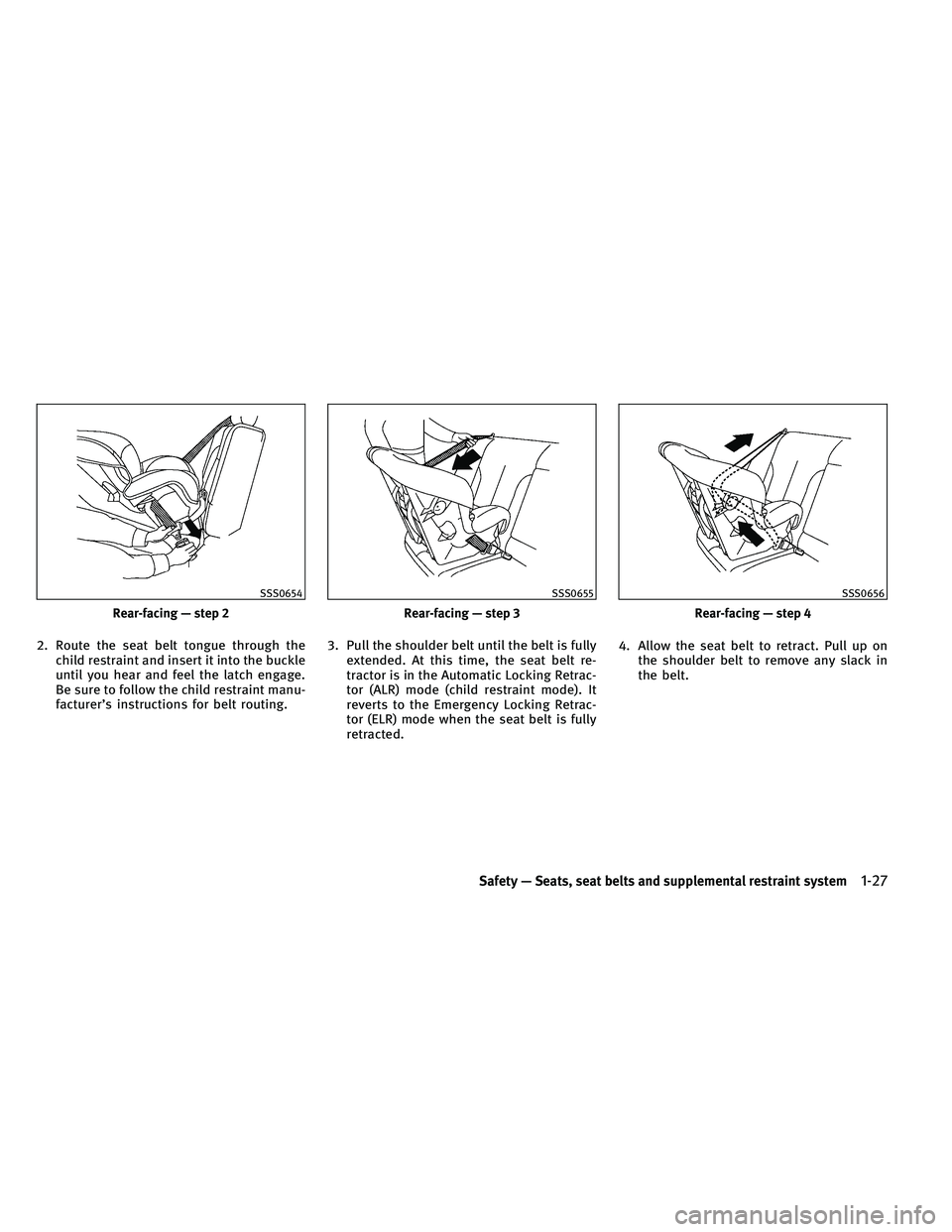
2. Route the seat belt tongue through thechild restraint and insert it into the buckle
until you hear and feel the latch engage.
Be sure to follow the child restraint manu-
facturer’s instructions for belt routing. 3. Pull the shoulder belt until the belt is fully
extended. At this time, the seat belt re-
tractor is in the Automatic Locking Retrac-
tor (ALR) mode (child restraint mode). It
reverts to the Emergency Locking Retrac-
tor (ELR) mode when the seat belt is fully
retracted. 4. Allow the seat belt to retract. Pull up on
the shoulder belt to remove any slack in
the belt.
Rear-facing — step 2
SSS0654
Rear-facing — step 3
SSS0655
Rear-facing — step 4
SSS0656
Safety — Seats, seat belts and supplemental restraint system1-27
Page 47 of 480
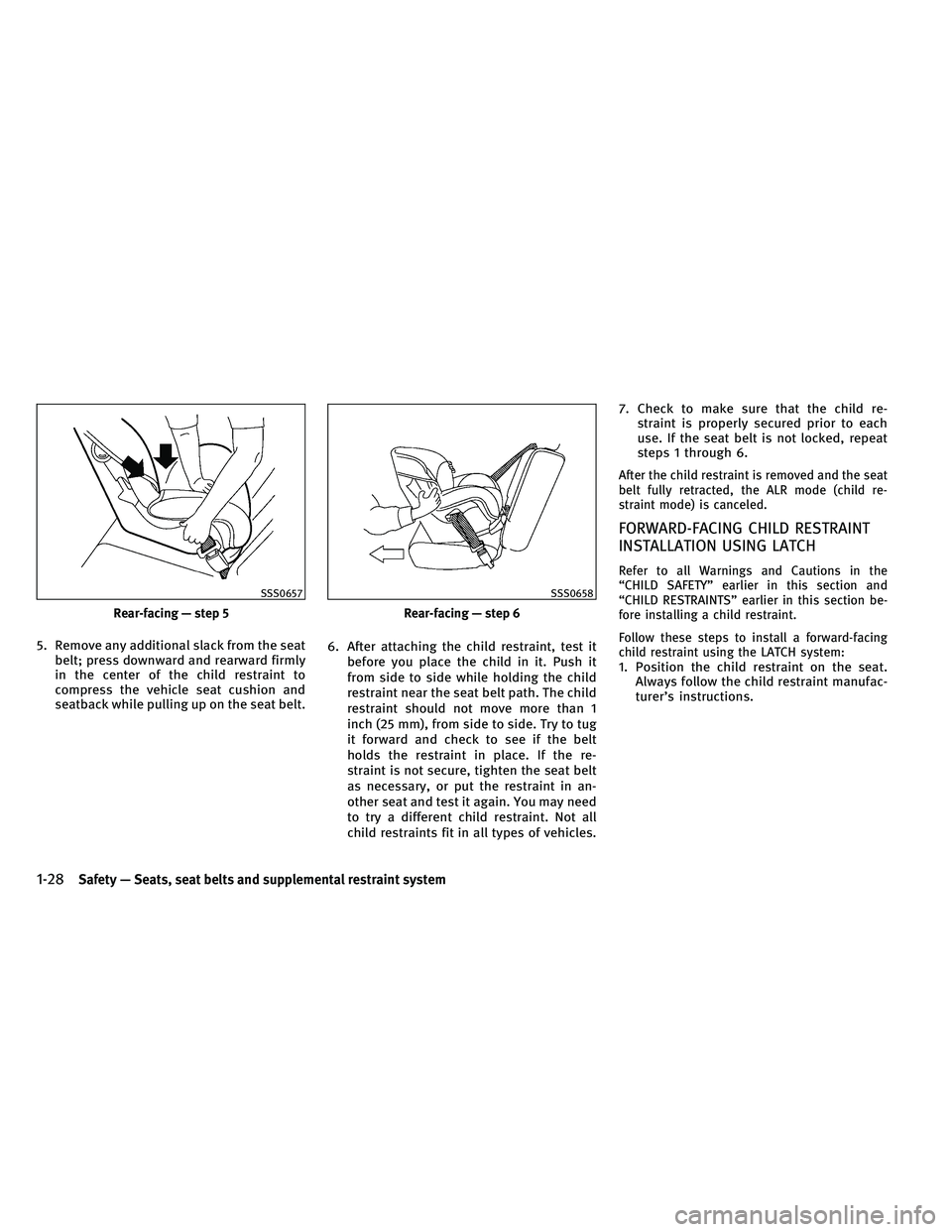
5. Remove any additional slack from the seatbelt; press downward and rearward firmly
in the center of the child restraint to
compress the vehicle seat cushion and
seatback while pulling up on the seat belt. 6. After attaching the child restraint, test it
before you place the child in it. Push it
from side to side while holding the child
restraint near the seat belt path. The child
restraint should not move more than 1
inch (25 mm), from side to side. Try to tug
it forward and check to see if the belt
holds the restraint in place. If the re-
straint is not secure, tighten the seat belt
as necessary, or put the restraint in an-
other seat and test it again. You may need
to try a different child restraint. Not all
child restraints fit in all types of vehicles. 7. Check to make sure that the child re-
straint is properly secured prior to each
use. If the seat belt is not locked, repeat
steps 1 through 6.
After the child restraint is removed and the seat
belt fully retracted, the ALR mode (child re-
straint mode) is canceled.
FORWARD-FACING CHILD RESTRAINT
INSTALLATION USING LATCH
Refer to all Warnings and Cautions in the
“CHILD SAFETY” earlier in this section and
“CHILD RESTRAINTS” earlier in this section be-
fore installing a child restraint.
Follow these steps to install a forward-facing
child restraint using the LATCH system:
1. Position the child restraint on the seat.Always follow the child restraint manufac-
turer’s instructions.
Rear-facing — step 5
SSS0657
Rear-facing — step 6
SSS0658
1-28Safety — Seats, seat belts and supplemental restraint system
Page 49 of 480
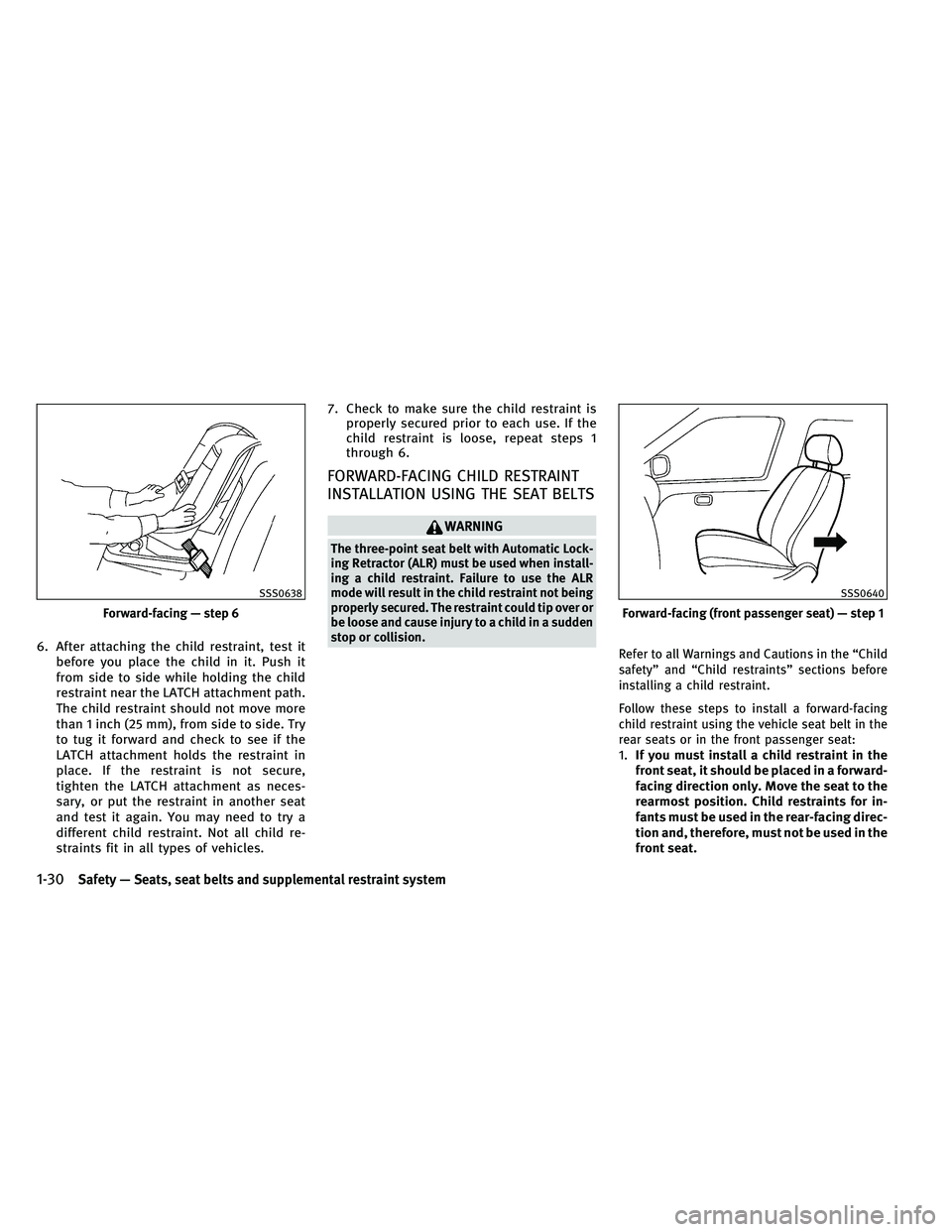
6. After attaching the child restraint, test itbefore you place the child in it. Push it
from side to side while holding the child
restraint near the LATCH attachment path.
The child restraint should not move more
than 1 inch (25 mm), from side to side. Try
to tug it forward and check to see if the
LATCH attachment holds the restraint in
place. If the restraint is not secure,
tighten the LATCH attachment as neces-
sary, or put the restraint in another seat
and test it again. You may need to try a
different child restraint. Not all child re-
straints fit in all types of vehicles. 7. Check to make sure the child restraint is
properly secured prior to each use. If the
child restraint is loose, repeat steps 1
through 6.
FORWARD-FACING CHILD RESTRAINT
INSTALLATION USING THE SEAT BELTS
WARNING
The three-point seat belt with Automatic Lock-
ing Retractor (ALR) must be used when install-
ing a child restraint. Failure to use the ALR
mode will result in the child restraint not being
properly secured. The restraint could tip over or
be loose and cause injury to a child in a sudden
stop or collision.
Refer to all Warnings and Cautions in the “Child
safety” and “Child restraints” sections before
installing a child restraint.
Follow these steps to install a forward-facing
child restraint using the vehicle seat belt in the
rear seats or in the front passenger seat:
1.If you must install a child restraint in the
front seat, it should be placed in a forward-
facing direction only. Move the seat to the
rearmost position. Child restraints for in-
fants must be used in the rear-facing direc-
tion and, therefore, must not be used in the
front seat.
Forward-facing — step 6
SSS0638
Forward-facing (front passenger seat) — step 1
SSS0640
1-30Safety — Seats, seat belts and supplemental restraint system
Page 50 of 480
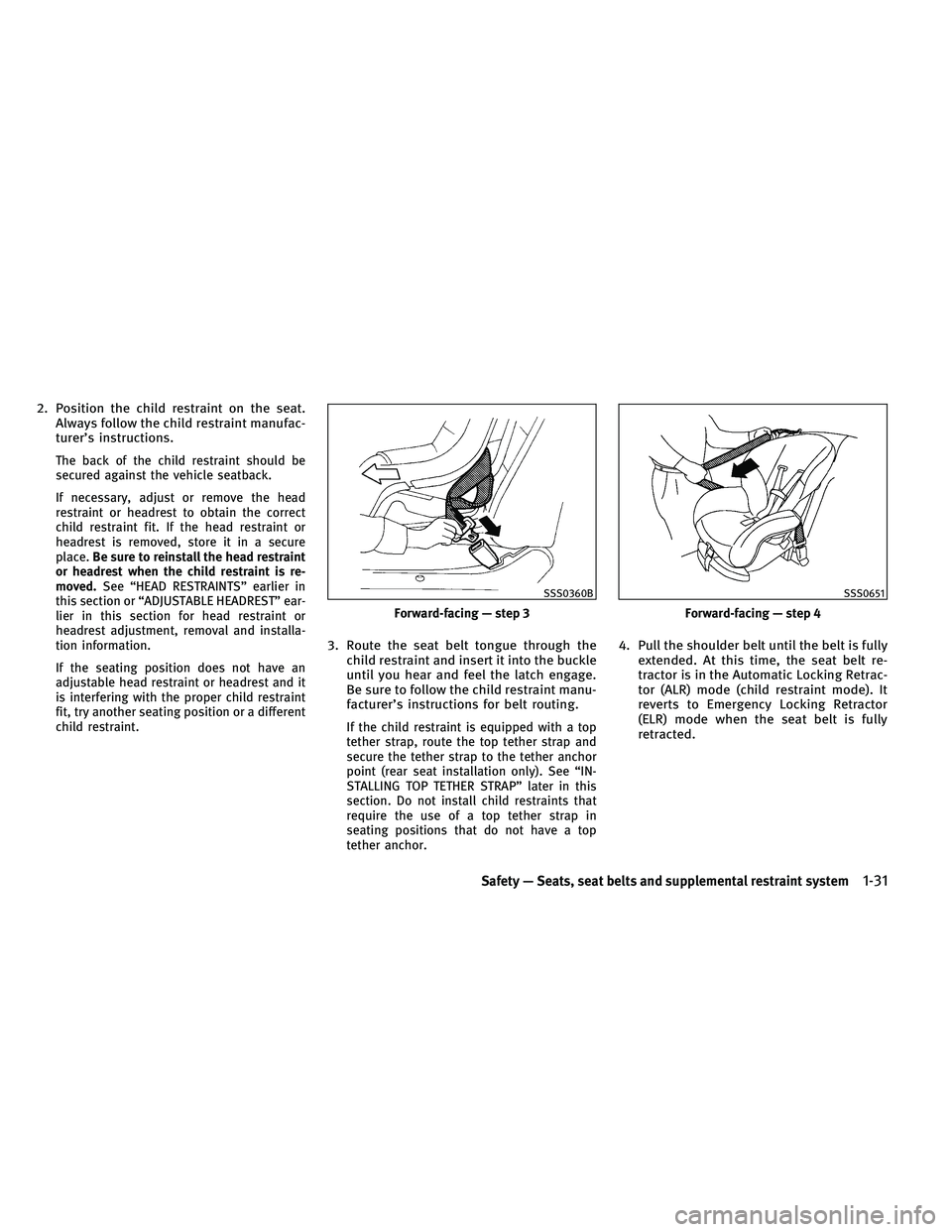
2. Position the child restraint on the seat.Always follow the child restraint manufac-
turer’s instructions.
The back of the child restraint should be
secured against the vehicle seatback.
If necessary, adjust or remove the head
restraint or headrest to obtain the correct
child restraint fit. If the head restraint or
headrest is removed, store it in a secure
place. Be sure to reinstall the head restraint
or headrest when the child restraint is re-
moved. See “HEAD RESTRAINTS” earlier in
this section or “ADJUSTABLE HEADREST” ear-
lier in this section for head restraint or
headrest adjustment, removal and installa-
tion information.
If the seating position does not have an
adjustable head restraint or headrest and it
is interfering with the proper child restraint
fit, try another seating position or a different
child restraint.
3. Route the seat belt tongue through the child restraint and insert it into the buckle
until you hear and feel the latch engage.
Be sure to follow the child restraint manu-
facturer’s instructions for belt routing.
If the child restraint is equipped with a top
tether strap, route the top tether strap and
secure the tether strap to the tether anchor
point (rear seat installation only). See “IN-
STALLING TOP TETHER STRAP” later in this
section. Do not install child restraints that
require the use of a top tether strap in
seating positions that do not have a top
tether anchor.
4. Pull the shoulder belt until the belt is fully extended. At this time, the seat belt re-
tractor is in the Automatic Locking Retrac-
tor (ALR) mode (child restraint mode). It
reverts to Emergency Locking Retractor
(ELR) mode when the seat belt is fully
retracted.
Forward-facing — step 3
SSS0360B
Forward-facing — step 4
SSS0651
Safety — Seats, seat belts and supplemental restraint system1-31
Page 52 of 480

9. Check to make sure the child restraint isproperly secured prior to each use. If the
seat belt is not locked, repeat steps 2
through 8.
10. If the child restraint is installed in thefront passenger seat, place the ignition
switch in the ON position. The front
passenger air bag status light
should illuminate. If this light is not
illuminated, see “Front passenger air
bag and status light” in this section.
Move the child restraint to another seat-
ing position. Have the system checked
by an INFINITI retailer.
After the child restraint is removed and the seat
belt is fully retracted, the ALR mode (child
restraint mode) is canceled.
INSTALLING TOP TETHER STRAP
First, secure the child restraint with the LATCH
lower anchors (rear outboard seating positions
only) or the seat belt, as applicable.
1. If necessary, raise or remove the headrest
to position the top tether strap over the
top of the seatback. If the headrest is
removed, store it in a secure place. Be
sure to reinstall the headrest when the
child restraint is removed. See “ADJUST-
ABLE HEADREST” earlier in this section for
headrest adjustment, removal and instal-
lation information.
2. Secure the top tether strap to the tether anchor point on the back of seatback
behind the child restraint.
Forward-facing — step 10
SSS0676SSS0841
Safety — Seats, seat belts and supplemental restraint system1-33
Page 54 of 480

●If the booster seat is compatible with your
vehicle, place your child in the booster seat
and check the various adjustments to be
sure the booster seat is compatible with
your child. Always follow all recommended
procedures.
All U.S. states and Canadian provinces or territo-
ries require that infants and small children be
restrained in an approved child restraint at all
times while the vehicle is being operated.
The instructions in this section apply to booster
seat installation in the rear seats or the front
passenger seat.
Booster seat installation
CAUTION
Do not use the lap/shoulder belt Automatic
Locking Retractor (ALR) mode when using a
booster seat with the seat belts.
Refer to all warnings and cautions in the “CHILD
SAFETY” earlier in this section, “CHILD RE-
STRAINTS” earlier in this section and “BOOSTER
SEATS” earlier in this section before installing a
booster seat.
Follow these steps to install a booster seat in
the rear seat or in the front passenger seat:
1. If you must install a booster seat in the
front seat, move the seat to the rearmost
position.
2. Position the booster seat on the seat. Only place it in a forward-facing direction.
Always follow the booster seat manufac-
turer’s instructions.
LRS0464SSS0640
Safety — Seats, seat belts and supplemental restraint system1-35